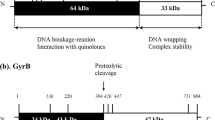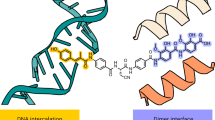Abstract
Albicidin is a potent DNA gyrase inhibitor produced by the sugarcane pathogenic bacterium Xanthomonas albilineans. Here we report the elucidation of the hitherto unknown structure of albicidin, revealing a unique polyaromatic oligopeptide mainly composed of p-aminobenzoic acids. In vitro studies provide further insights into the biosynthetic machinery of albicidin. These findings will enable structural investigations on the inhibition mechanism of albicidin and its assessment as a highly effective antibacterial drug.
This is a preview of subscription content, access via your institution
Access options
Subscribe to this journal
Receive 12 print issues and online access
$259.00 per year
only $21.58 per issue
Buy this article
- Purchase on Springer Link
- Instant access to full article PDF
Prices may be subject to local taxes which are calculated during checkout


Similar content being viewed by others
References
Young, J.M., Park, D.C., Shearman, H.M. & Fargier, E. Syst. Appl. Microbiol. 31, 366–377 (2008).
Royer, M. et al. Mol. Plant Microbe Interact. 17, 414–427 (2004).
Dal-Bianco, M. et al. Curr. Opin. Biotechnol. 23, 265–270 (2012).
Birch, R.G. & Patil, S.S. Phytopathology 73, 1368–1374 (1983).
Birch, R.G. & Patil, S.S. Physiol. Mol. Plant Pathol. 30, 207–214 (1987).
Birch, R.G. & Patil, S.S. Physiol. Mol. Plant Pathol. 30, 199–206 (1987).
Birch, R.G. & Patil, S.S. Antibiotic and process for the production thereof. US patent 4,525,354 (1985).
Hashimi, S.M., Wall, M.K., Smith, A.B., Maxwell, A. & Birch, R.G. Antimicrob. Agents Chemother. 51, 181–187 (2007).
Corbett, K.D. & Berger, J.M. Annu. Rev. Biophys. Biomol. Struct. 33, 95–118 (2004).
Maxwell, A. & Lawson, D.M. Curr. Top. Med. Chem. 3, 283–303 (2003).
Vivien, E. et al. Antimicrob. Agents Chemother. 51, 1549–1552 (2007).
Dosselaere, F. & Vanderleyden, J. Crit. Rev. Microbiol. 27, 75–131 (2001).
Stachelhaus, T. & Marahiel, M.A. FEMS Microbiol. Lett. 125, 3–14 (1995).
Du, L., Sanchez, C., Chen, M., Edwards, D.J. & Shen, B. Chem. Biol. 7, 623–642 (2000).
Aravind, L., Anantharaman, V. & Koonin, E.V. Proteins 48, 1–14 (2002).
Huang, G., Zhang, L. & Birch, R.G. Gene 255, 327–333 (2000).
Koglin, A. et al. Science 312, 273–276 (2006).
Tanovic, A., Samel, S.A., Essen, L.O. & Marahiel, M.A. Science 321, 659–663 (2008).
Stachelhaus, T., Mootz, H.D. & Marahiel, M.A. Chem. Biol. 6, 493–505 (1999).
Birch, R.G. & Patil, S.S. J. Gen. Microbiol. 131, 1069–1075 (1985).
Zhang, L., Xu, J. & Birch, R.G. J. Appl. Microbiol. 85, 1023–1028 (1998).
Altschul, S.F., Gish, W., Miller, W., Myers, E.W. & Lipman, D.J. J. Mol. Biol. 215, 403–410 (1990).
McWilliam, H. et al. Nucleic Acids Res. 41, W597–W600 (2013).
Bachmann, B.O. & Ravel, J. Methods Enzymol. 458, 181–217 (2009).
Zhang, Y. BMC Bioinformatics 9, 40 (2008).
Bogomolovas, J., Simon, B., Sattler, M. & Stier, G. Protein Expr. Purif. 64, 16–23 (2009).
Acknowledgements
This work was supported by a grant from the Deutsche Forschungsgemeinschaft (DFG SU239/11-1; SU 18-1), by the Cluster of Excellence 'Unifying Concepts in Catalysis (UniCat)' (DFG) and by a grant from the Agence Nationale de la Recherche (ANR-09-BLAN-0413-01).
Author information
Authors and Affiliations
Contributions
S.C., A.P., S.D., M.M., J.N., I.P., M.H., P.R. and M.R. performed the cultivation and isolation of albicidin. A.P., D.P., V.S., S.K. and A.M. performed the structural elucidation of albicidin. D.P., S.U., A.M. and M.R. performed the bioinformatic analysis of the biosynthesis genes. D.P., S.U. and M.H. produced the proteins and performed the in vitro assays. J.K. synthetized the substrates for the in vitro assay. S.C., A.P., D.P., A.M., M.R. and R.D.S. designed the study and analyzed the data. S.C., A.P., D.P., L.V., A.M., M.R. and R.D.S. wrote the manuscript.
Corresponding authors
Ethics declarations
Competing interests
The authors declare no competing financial interests.
Supplementary information
Supplementary Text and Figures
Supplementary Results, Supplementary Tables 1–6 and Supplementary Figures 1–12. (PDF 2134 kb)
Rights and permissions
About this article
Cite this article
Cociancich, S., Pesic, A., Petras, D. et al. The gyrase inhibitor albicidin consists of p-aminobenzoic acids and cyanoalanine. Nat Chem Biol 11, 195–197 (2015). https://doi.org/10.1038/nchembio.1734
Received:
Accepted:
Published:
Issue Date:
DOI: https://doi.org/10.1038/nchembio.1734
This article is cited by
-
Molecular mechanism of topoisomerase poisoning by the peptide antibiotic albicidin
Nature Catalysis (2023)
-
Comparative genome analysis unravels pathogenicity of Xanthomonas albilineans causing sugarcane leaf scald disease
BMC Genomics (2022)
-
Lapcin, a potent dual topoisomerase I/II inhibitor discovered by soil metagenome guided total chemical synthesis
Nature Communications (2022)
-
In vivo and in vitro reconstitution of unique key steps in cystobactamid antibiotic biosynthesis
Nature Communications (2021)
-
Albicidin, a potent DNA gyrase inhibitor with clinical potential
The Journal of Antibiotics (2019)



